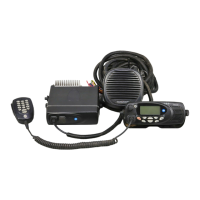TM8100/TM8200 Service Manual Circuit Descriptions 93
© Tait Electronics Limited November 2007
Input Signals
(AUX GPI1 to AUX GPI3)
Dedicated inputs are provided on three pins of the auxiliary connector
(
AUX GPI1 to AUX GPI3). AUX GPI1 is a general-purpose input with strong
protection of the same type used for
AUX GPIO4. AUX GPI2 is normally a
dedicated emergency input but can be made a general-purpose input like
AUX GPI1 by removing the link LK3 in the power supply area. AUX GPI3 is
normally a dedicated ignition-sense input but can be made a general-
purpose input like
AUX GPI1 by removing the link LK2 in the power supply
area and fitting the 33kΩ resistor R775.
ESD Protection On exposed inputs of the auxiliary and control-head connectors ESD
(electrostatic discharge) protection is provided by a 470pF capacitor and by
clamping diodes to ground and to 13.8V. For example, on
AUX GPIO4 this
consists of D713 and C725. The lines
IOP GPIO1 to IOP GPIO7 are intended for
connection to internal digital devices and so these have relatively light
protection.
Hookswitch
Detection
Hookswitch detection is performed by Q700, R709, R706 and R712.
When the resistance to ground on the PTT line is less than 13.2kΩ, Q700
will turn on and drive the
ITF CH HOOK line high; this indicates either that the
microphone is on hook or that the PTT (press-to-talk) switch is pressed.
3.8 Digital Board
Introduction Different digital boards are used for the TM8200 and TM8100 radios.
For a block diagram of the digital board of the TM8200 radios, refer to
Figure 3.13. For a block diagram of the digital board of the TM8100 radios,
refer to Figure 3.14.
The digital board is not serviceable at level-2 and is not described in this
manual.

